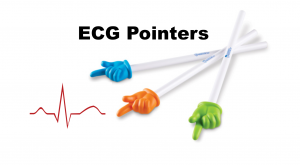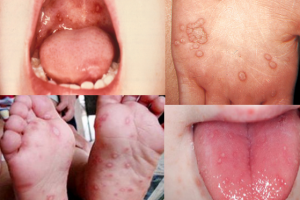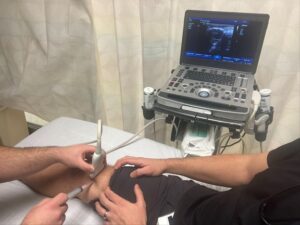Today on the emDOCs cast with Brit Long, MD (@long_brit), we cover the literature on evaluation and management of the adult patient with meningitis.
Episode 115: Adult Meningitis
Background:
- Meningitis is an inflammation of the subarachnoid space, the leptomeninges, and cerebrospinal fluid.
- Associated with a variety of causes, but a bacterial infection is one of the more dangerous ones.
- Bacterial meningitis is not common, but it can be devastating if missed.
- Neurologic deficits, seizures, cognitive issues, hearing loss.
- Mortality rate is 10-30%.
- Presentation can vary, and the diagnosis can be challenging.
Presentation:
- Classic Triad = fever, nuchal rigidity, and altered mental status.
- Present in <40 % of cases.
- Almost all patients have at least one of these three symptoms.
- 95% of patients with bacterial meningitis have two symptoms.
- ~ 70% have nuchal rigidity.
- >50% of patients have confusion/altered mental status.
- 90% of patients have a headache.
- Patients may have nausea/vomiting.
- What about Kernig’s sign and Brudzinski’s sign?
- Kernig’s signs = pain in the lower back on passive knee extension
- Brudzinski’s sign = passive neck flexion that leads to flexion of the knees and hips when the patient is supine
- Neither are sensitive for bacterial meningitis.
- What about the jolt accentuation test?
- Positive Jolt accentuation test = patient turns their head horizontally 2-3 times per second and their headache gets worse.
- A 1991 study found a sensitivity >97% and a specificity of 60%.
- Studies after that first publication have not replicated those numbers.
- A 2020 Cochrane review found the pooled sensitivity was 65%.
- Do not rely on this to rule out bacterial meningitis.
Bacterial Meningitis Mimics:
- Other flu-like illnesses: COVID, influenza, toxic shock syndrome, myocarditis, endocarditis, spinal epidural abscess, pneumonia.
- Toxicity: Carbon monoxide poisoning
Time Course:
- Typically, a rapidly progressing disease process.
- Can be a smoldering infection in patients with immunocompromising conditions.
- Consider cryptococcus meningitis in these patients.
Recommended testing:
- Serum lab tests are commonly obtained, but they are not helpful in ruling in or out bacterial meningitis.
- Cerebrospinal fluid analysis (ideally within 1 hour of presentation to ED) is necessary.
- CSF tests:
- Appearance – color and viscosity of fluid
- Cell Count – neutrophil predominant, WBC > 1000 per μL
- Glucose – decreased
- Protein – increased
- Gram stain – specificity >95%; sensitivity between 50-90%
- Culture – will not result while the patient is in the ED
- PCR microarray – sensitivity >96%
- Looks for common bacterial and viral species
- PCR will be positive after antibiotics have been given
- Results quickly
- CSF Lactate – normal is 1.2-2.1 mM. A CSF lactate > 3.5 mM has a sensitivity > 96% for bacterial meningitis. It can be lower if the patient got antibiotics before LP.
- Latex agglutination test – rapid test for organisms like Neisseria or Streptococcus spp, but the sensitivity is variable, between 10-100%.
- Opening pressure – not absolutely essential
- The patient is placed in a lateral recumbent position.
- Opening pressure is typically elevated in bacterial meningitis
- The initial pressure from the manometer is in cmH2O. Multiply that by 0.7 to get results in mmHg.
- Over 20-22 mmHg or 27 cmH2O is elevated.
- Lumbar puncture is contraindicated in the following:
- DIC
- Thrombocytopenia (platelets less than 40k)
- Antithrombotic use (may lead to hematoma)
- Reverse warfarin to INR <1.4
- Risk vs. benefits if the patient is on DOAC or clopidogrel; consult hematology.
- Aspirin is not a risk.
Differentiating viral meningitis versus bacterial meningitis:
- CSF:
- Normal opening pressure
- Cell count – lymphocyte-predominant white blood cell count that’s elevated, but it’s usually less than 1000.
- Protein – elevated in the 30-200 mg/dL range
- Glucose – normal
- CSF Lactate – < 3.5 mM in most cases.
- Caveat: Bacterial meningitis can present with a cell count of less than 1000 (less than 10% of cases).
- Culture or CSF PCR is necessary to rule out bacterial meningitis.
- If the patient looks sick, assume it’s bacterial until proven wrong by culture or PCR.
What about a CT before a Lumbar puncture?
- Four practice guidelines discuss when a CT should be performed before LP (IDSA, UK, European Society of Clinical Microbiology and Infectious Diseases, Sweden)
- CT should be obtained if the patient has:
- Evidence of increased intracranial pressure (ICP)
- Neurologic deficit
- Altered mental status
- New seizure
- Caveats:
- CT should not delay treatment with antibiotics.
- CT does not adequately determine the risk of herniation (risk is 1-8% in patients with bacterial meningitis).
Treatment:
- Early antibiotics are key:
- Every hour delay in antibiotic initiation increases morbidity and mortality.
- Third-generation cephalosporin (ceftriaxone 2 gm or cefotaxime 2 gm) plus vancomycin.
- Increased resistance of Streptococcus pneumoniae and Neisseria meningitis to cephalosporins and penicillin.
- Another regimen is rifampin plus amoxicillin/ampicillin/penicillin G.
- Rifampin in place of the vancomycin for the drug-resistant Streptococcus, safer if there’s acute kidney injury
- If the patient is >50 yo, has diabetes, cancer, immunosuppression – include coverage for Listeria monocytogenes.
- Add amoxicillin/ampicillin/penicillin G OR Meropenem
- What about antivirals?
- Give acyclovir If there is concern for HSV encephalitis (focal neurologic deficits, seizures, markedly depressed mental status, or immunocompromise)
- The mortality rate for HSV encephalitis is up to 70%. The benefits of giving acyclovir far outweigh any risks.
- HSV meningitis needs hospital admission.
- What about steroids?
- Give steroids within 4 hours of presumptive diagnosis.
- Dexamethasone 0.15 mg/kg IV every 6 hours for 2-4 days.
- Reduce inflammation within the CSF and subarachnoid space caused by bacterial lysis from antibiotics.
- Decrease morbidity and mortality.
- More helpful in patients with pneumococcal meningitis.
- Dexamethasone
- Give steroids within 4 hours of presumptive diagnosis.
- Reduce Intracranial Pressure (ICP):
- Bacterial meningitis reduces CSF reabsorption, leading to increased ICP.
- Increased ICP leads to cerebral edema and hydrocephalus.
- It is not necessary to reduce ICP in ALL patients with bacterial meningitis.
- Altered mental status, focal neurologic deficit, large optic nerve sheath diameter, or elevated opening pressure on LP.
- Goal is to reduce elevated ICP & improve cerebral perfusion pressure (CPP).
- MAP minus the ICP equals CPP.
- The target CPP is at least 60.
- So, if the patient has an elevated ICP of 20, you want a MAP of about 80. That gives a CPP of 60. (MAP 80-ICP 20= CPP 60).
- Start resuscitating with fluids, and add a vasopressor like norepinephrine.
- If you know the ICP, you can titrate the MAP.
- If you haven’t checked the ICP, target a MAP of 75-80.
- While doing all of this, you need to reduce the ICP.
- Start by raising the head of the bed.
- Give either hypertonic saline or mannitol.
- Hypertonic saline: Give a bolus 250 mL of 3%.
- Mannitol: Give 1.5 g/kg and then place a foley to track urine output and match the output with IV fluids. (Harder outside of an ICU setting)
- Therapeutic drainage of CSF?
- Not typically done in the ED.
- Recurrent LP or lumbar drain that’s placed by neurosurgery.
- Usually reserved for patients with a significantly elevated ICP and t= no structural abnormality of the CT.
- Most often needed in patients with cryptococcal meningitis.
- Patients require admission.
References:
- Pajor MJ, Long B, Koyfman A, Liang SY. High risk and low prevalence diseases: Adult bacterial meningitis. Am J Emerg Med. 2023 Mar;65:76-83. Epub 2022 Dec 28. PMID: 36592564.
- Uchihara T, Tsukagoshi H. Jolt accentuation of headache: the most sensitive sign of CSF pleocytosis. Headache. 1991;31(3):167-171.PMID: 2071396
- Iguchi M, et al. Diagnostic test accuracy of jolt accentuation for headache in acute meningitis in the emergency setting. Cochrane Database Syst Rev. 2020;6(6):CD012824. Published 2020 Jun 11. PMID: 32524581
- Tunkel AR, et al. Practice guidelines for the management of bacterial meningitis. Clin Infect Dis. 2004;39(9):1267-1284. PMID: 15494903
- McGill F, et al. The UK joint specialist societies guideline on the diagnosis and management of acute meningitis and meningococcal sepsis in immunocompetent adults [published correction appears in J Infect. 2016 Jun;72 (6):768-769]. J Infect. 2016;72(4):405-438. PMID: 26845731
- van de Beek D, Cabellos C, Dzupova O, et al. ESCMID guideline: diagnosis and treatment of acute bacterial meningitis. Clin Microbiol Infect. 2016;22 Suppl 3:S37-S62. PMID: 27062097
- Glimåker M, Johansson B, Bell M, et al. Early lumbar puncture in adult bacterial meningitis–rationale for revised guidelines. Scand J Infect Dis. 2013;45(9):657-663. PMID: 23808722







